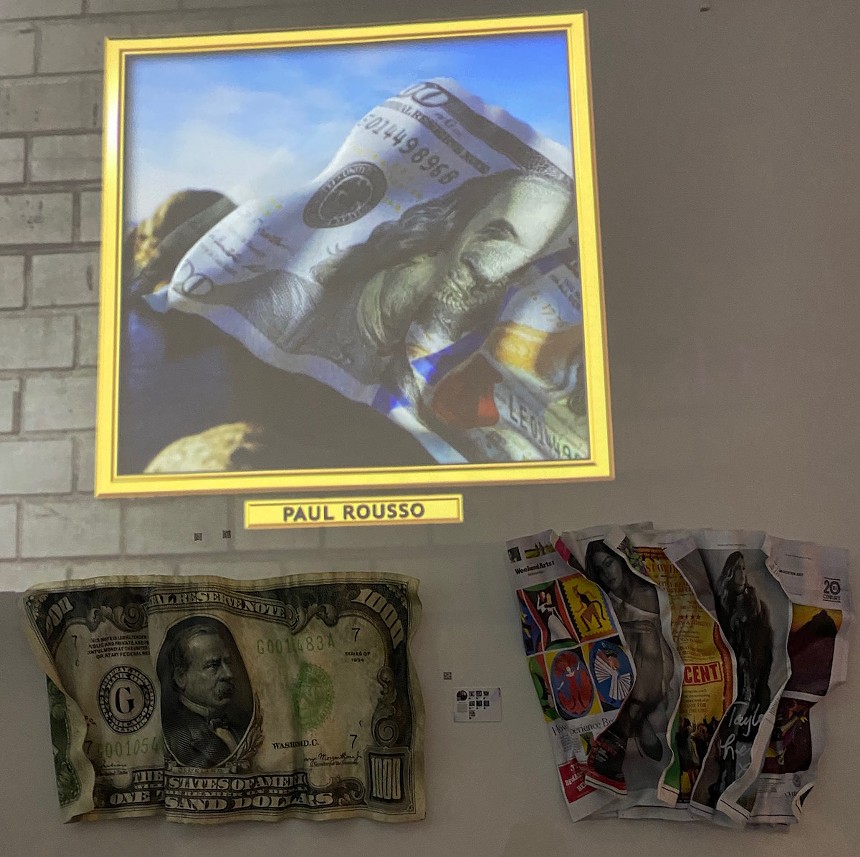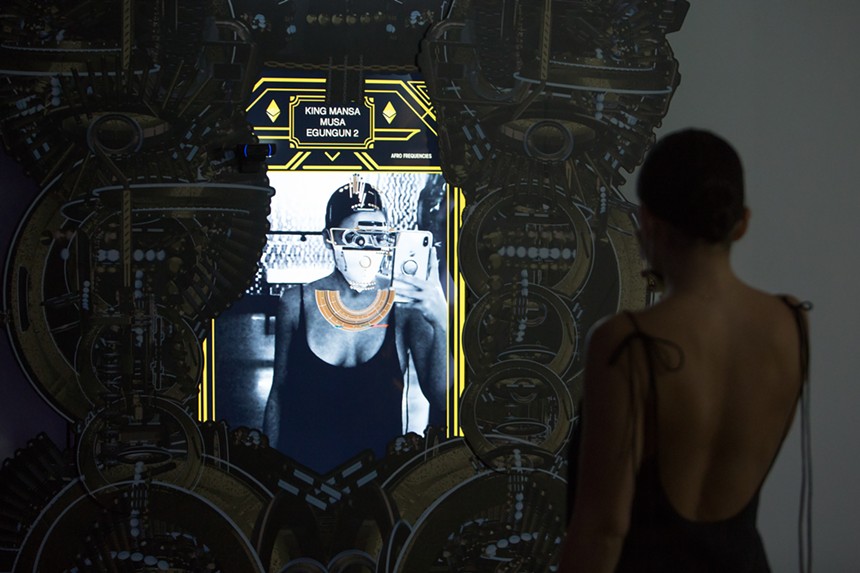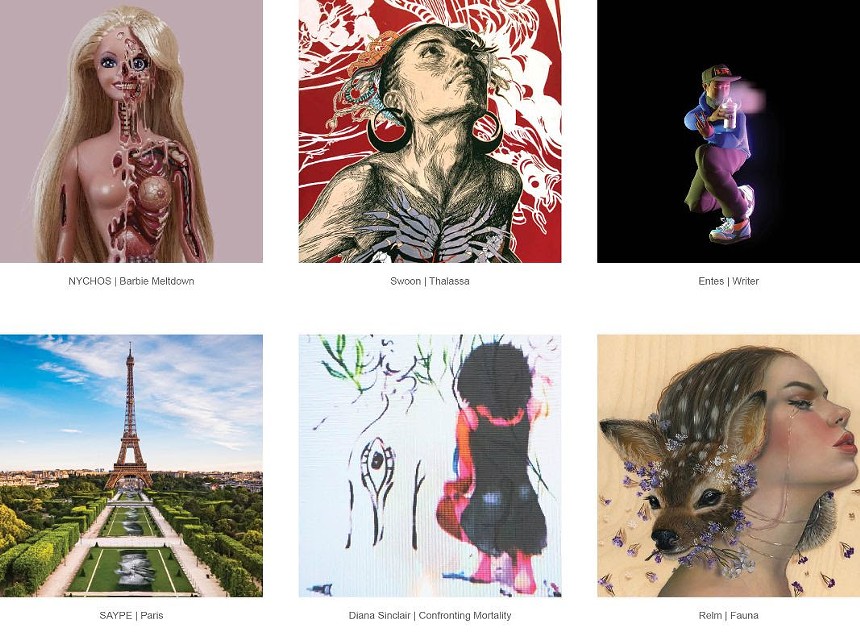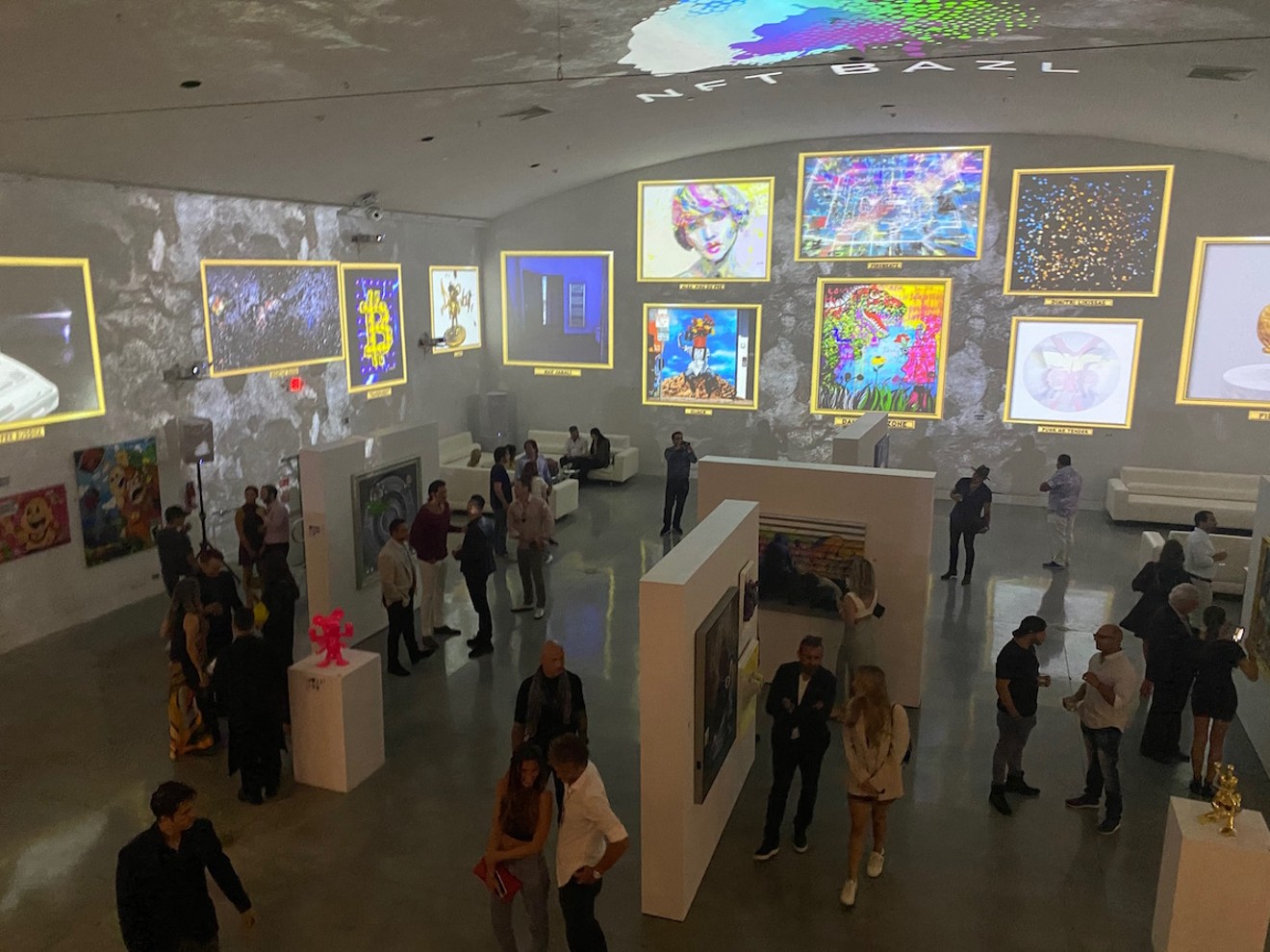Paul Rousso's billboard-sized crinkled dollar bills, Mario Henrique's mixed-media portraits with colorful splashes and paint throws, and Hijack's canvases of faceless urban youth were not in the spotlight at the NFT BAZL gallery auction, which took place in Miami Beach during the Bitcoin 2021 conference in June. The lights at the Temple House were dimmed so low that the finer details of the artworks hanging on the walls — listed with five-digit starting prices — were barely visible.
That's because the auction was centered on the moving images projected beside each physical work as a digital interpretation by the artist — also for sale, though the buyer would never be able to physically touch their purchase. The projections represented non-fungible tokens, more commonly known as NFTs — digital assets that have had their authenticity and ownership verified via a tamperproof network of computers called the blockchain that meticulously tracks transactions.
For many of the artists, the auction represented their first venture into the wild, wild online world of NFTs. That evening, the more traditional art collectors — clad in cocktail dresses, tailored Italian suits, and Rolexes — seemed curiously amateur, too, scanning the QR codes beside each work like restaurant menus to be directed to an online platform where they could bid on the physical and digital artworks that might go for more than a Honda Civic. They sipped Champagne from glass flutes alongside out-of-town tech yuppies whose preferred outfit leaned toward monochromatic T-shirts and sneakers and whose beverage of choice was Stella Artois straight from the longneck bottle.
Though NFTs were typically listed at roughly 70 percent of the starting price of the physical artworks, the auctions for the NFTs tended to be more competitive. By the end of the auction, one token sold for more than $300,000. (Both credit cards and cryptocurrency were accepted.)
"NFTs are the future, and this is the way forward," NFT BAZL CEO Estelle Ohayon told New Times. "In the art world, you're either one step ahead or ten behind and trying to catch up."

Less than six months after NFT BAZL billed itself as the world's first physical NFT gallery, Miami Art Week and Art Basel are bringing a veritable virtual deluge, and with it, its vocabulary of "blockchains," "cryptocurrencies," "drops," and apparent allergy to words with vowels. From absurd fluffy rabbit avatar NFTs to 3D NFT hologram shows to curated, blue-chip NFT fairs, more than a dozen events around the Magic City will incorporate NFTs in one way or another. But will the buzz around this trendy acronym be a momentary flash in the pan, or will it eventually become a respected and lasting form that will disrupt the traditional art world?
"The digitalization of art is eliminating boundaries," Ohayon says. "It's really a social revolution."
For the uninitiated, it might help to think of NFTs as a medium unto itself — like, say, ceramics or photography — which can encompass coffee mugs to Ai Weiwei, drunken selfies to Ansel Adams. NFTs don't have to be visual art in the traditional sense: Twitter CEO Jack Dorsey sold his first tweet as an NFT for $2.9 million, and Kings of Leon released an album as a series of NFTs. But perhaps no industry has been more seismically revolutionized by NFTs as the art world, especially after artist Mike Winkelmann, known as Beeple, sold a digital collage of thousands of his images at Christie's this past March for $69.3 million, the third-highest auction price for a work by a living artist.
Some of the more traditional artists and collectors are dismissive of the 8-bit-style and cartoonish CryptoKitties or Crypotpunks NFTs, some of which have fetched as much as $140,000. But others look at the medium as a welcome disruption to an otherwise stuffy and elitist art world. NFTs allow outsider artists to compete on an even international playing field, and if their careers skyrocket months, years, and, hypothetically, even centuries later, the artists (or their designated beneficiaries) receive a sizable percentage on the resale of their original works. To put that into context, that would be like Marina Picasso receiving somewhere between 10 to 25 percent of the $103.4 million sale of her late grandfather's 1932 portrait of Marie-Thérèse Walter. An unidentified buyer purchased the work for $45 million in 2013 and reaped a $58 million profit at auction in May.
"People who are unheard-of, artists who were working at gas stations — this younger generation suddenly has a voice without needing to be well-connected to an agent or curator," Ohayon says. "The art market is very, very elite, and we're seeing artists break through that without having to have graduated from Parsons [School of Design]."
Husband-and-wife art collectors Mera and Don Rubell are one of the city's pioneering art families, credited with not just transforming a neighborhood when they opened the Rubell Family Collection in Wynwood in 1993, but also putting the region on the international art-world map when they successfully petitioned for Art Basel to come here in 2002.
More than anything, the Rubells are lauded for their foresight, their ability to spot potential in neglected neighborhoods and unknown and emerging artists alike. The family has since moved its collection from Wynwood to Allapattah, where the Rubell Family Museum now showcases the fruits of some of the couple's greatest instincts: a 1979 Jeff Koons vacuum, Catherine Opie portraits from the early '90s — works purchased cheaply by little-known artists only to have their value increase exponentially over time.
"Contemporary art feels right in new frontiers," Mera Rubell tells New Times, referring not only to the family's decision to relocate to Allapattah but also to NFTs. "Form follows function and function follows form."
Rubell admits she doesn't have the best grasp of NFTs — the exorbitant prices, the blockchain, the ERC-721 Smart Contracts — but she's interested.
"No one really understands NFTs, but that's what art is all about: new creative ideas," she says. "I'm always looking for art to teach me, and I trust that artists are going to come up with new ideas. We're waiting for the artists to teach us what NFTs are all about."

When it comes to bringing the traditional art world — and its deep pockets — to the blockchain, education is key, explains Ashley Ramos, an artist and collector who worked in traditional gallery spaces and until becoming head of partnerships at the NFT marketplace Nifty Gateway.
"There are digital-native artists that spearheaded the NFT boom, but since then, mixed-media and multidisciplinary artists have furthered their practice by reinterpreting their traditional background — classical oil painting, photography, videography — to an NFT base," Ramos says. "In the next three to five years, we are going to see a 20 percent increase in NFT visibility in institutional or gallery spaces."
NFTs are often dismissed as not being art — a misconception that makes Ramos sigh. She compares that derision to the subjectivity of contemporary art more broadly.
"A great example is Mark Rothko, painting heavily with the same color over and over again, creating a richness and texture. Some people might look at that and think, Well I can do a bunch of colored squares on a canvas, how did that auction for $46 million?" Ramos explains. "Someone could say the same for Keith Haring or a Jackson Pollack. The question becomes: How did that make you feel when you looked at it?"
And, with no corporeal limitations, looking at your collection of NFTs is as easy as opening an app on your phone.
"Some of the most incredible, iconic art is in storage, where no one can see it," says Ramos, who collects both physical and digital art. "If I wanted to show someone my physical collection, I'd have to take you to three geographical locations, whereas with the Nifty Gateway app on my phone I can, in real time, show you 11 pieces of original art."
Digital art was on the upswing long before Beeple's $69.3 million NFT sale. In late 2018, Artechouse (styled ARTECHOUSE), a brick-and-mortar gallery exhibiting digital, experiential art, opened in an art deco building on Collins Avenue in South Beach. At first it was easy to dismiss the programming as a highbrow selfie museum, but the location created a way for guests to publicly interact with digital art in ways that had never been done amid the bright lights and white walls of traditional galleries.
Take Artechouse's current exhibit, "ASE: Afro Frequencies," which allows guests to virtually try on reimagined designs of African masks dating as far back as the 12th Century like an Instagram filter as recordings of poet Ursula Rucker's words play in the background. The exhibition is London-based Afro-surrealist digital artist Vince Fraser's first solo exhibition of his interactive and immersive works.
During Bitcoin 2021 in June, Nifty Gateway, Artechouse, and Fraser partnered to create an NFT auction of actual snippets of the exhibition. Four works were available for NFT auction: two on Nifty Gateway's online marketplace with starting bids at $2,500, and two that were minted in editions of 20 apiece that were offered on-site, via a $250 drawing.
"NFTs have brought upon a whole art renaissance — it's something I've been praying to come along working 20 plus years in digital art," Fraser tells New Times. "NFTs can change the lives of artists — we can be richer than celebrities, whereas before we were the starving artists."
Fraser, who worked professionally as a digital illustrator, is optimistic about the medium's capacity to pass along the lion's share of the original sale to the artist, not to mention the blockchain, which passes on a portion of the profit from future resales.
"The power of NFTs is that it's quite promising for underprivileged and marginalized creators because it allows them to get in a space and collaborate on a level playing field whereas before you had gatekeepers and a lot of people just didn't 'get' certain types of work," Fraser says. "It also gives you financial freedom, and an opportunity to monetize on your creativity."
June's NFT drop marked the first time Artechouse released an NFT, yet founder Sandro Kereselidze says popular demand inspired the gallery to plot a second drop at their New York outpost with artist Julius Horsthuis.
"Everyone really connected with the idea of becoming collectors and leaving with a nontraditional souvenir," Kereselidze tells New Times. "While the specifics of NFTs may change, I think that their ability to draw more people into the art world and collecting is a trend that is here to stay."

Though Art Basel Miami Beach was canceled last year owing to the coronavirus, as Miami Art Week, Basel, and the crop of satellite fairs return in-person, the prominence of NFTs suggests that their shelf life extends beyond the pandemic, which moved everything online by force, not choice.
"There has always been a void of digital art at the art fairs, as it has been treated as uncollectible, but with NFTs I think this is about to change," Kereselidze predicts. "It will be interesting to see what kind of NFTs we will see and how these are perceived and received by more traditional collectors and the public."
Ashley Ramos confirms that Nifty Gateway will return to Miami to host "three very large activations" during Miami Art Week that will center on educating the traditional art community about investing in digital art.
NFT BAZL will also debut "the first-ever boutique NFT marketplace" by offering exclusive NFT-only artworks for sale on the TVs in every room at the SLS hotels in South Beach and Brickell.
Another event with even less vowels called NFT BZL will host a conference at FTX Arena, home of the Miami Heat, on November 30, dedicated to all things NFT, with panels, digital galleries, activations, and high-profile speakers from Christie's, the British auction house founded in 1766, to Nifty Gateway, founded in 2018. Miami's "tech bro" mayor, Francis Suarez, is confirmed to speak (despite the fact that his recent "How Can I Help?" NFT collection, which aimed to benefit a coding boot camp in Little Haiti, received only one lone bid).
This month, the SCOPE Art Show returns to the sands along Ocean Drive for its 20th anniversary. As one of the longest-running satellite fairs at Art Basel Miami Beach, SCOPE is known for featuring divergent works by young and emerging artists. This year, SCOPE president Alexis Hubshman tells New Times, the fair will include a wall of flat screens displaying NFT artworks for sale.
And rather than selling ordinary paper VIP tickets, SCOPE is offering limited-edition NFTs patrons must purchase in order to procure VIP entry. Ten NFTs are available, each in an edition of 200 and created by artists in the show; they'll sell for roughly the price of a VIP (or Platinum VIP) ticket in years past.
"You're used to buying a ticket — isn't it cool that you don't just throw it in the garbage, that with the same money, in this case, you have an artifact?" Hubshman notes, adding that the artists will receive 50 percent of the original sale of the NFT ticket within seconds of the transaction being processed on the blockchain, and then receive 20 percent on any resale of that work.
Some tickets listed at $200 have already increased to $216 because prices are tied to the value on the blockchain.
While some ticket buyers might be tempted to flip their NFT before the fair, Hubshman warns that these NFTs are the only way to enter. "Some might find that it might be more valuable to sell your ticket," he says, comparing it to scalping. "But if you trade your ticket, you no longer have a ticket."
While SCOPE is certainly one of the more tech-forward and forward-thinking fairs, Hubshman isn't surprised that NFTs are featuring prominently this year.
"I don't know if [NFTs will] be at every booth," he says. "But I suspect other satellite fairs — and definitely SCOPE — will be more tech-forward and take bigger risks and experiment with what the [NFT] market is like. We're certainly curious."
This past May, Cube Art Fair displayed 100 artworks created by artists during lockdown on billboards, kiosks, newsstands, and bus stops across New York City. This December, Cube, which calls itself the "world's largest public art fair," will host its "NFT edition" and physically showcase NFT-only works by internationally known artists, some of whom have had their physical artworks featured at Art Basel Miami Beach and the Venice Biennale. Depictions of the NFT artworks will appear on 50 billboards across Miami, but the main attraction will be a 400-foot-tall projection of a mural onto the façade of the InterContinental Hotel downtown. A QR code will accompany the public works and direct viewers to an online platform to purchase as an NFT.
A curious 12-by-24-foot "NFT monolith" is slated to appear on Flagler Street in that will feature close to 100 artists' NFT works, ranging from artist Jesse Woolston who sold his first NFT for nearly $50,000 and Le Fanhawk, a transmedia artist debuting an NFT clothing line (whatever that means). It's being hosted by ArtRepublic, a curation agency specializing in contemporary digital art, and SuperRare, an NFT marketplace working to identify and establish blue-chip digital artists.
But as NFT activations and NFT fairs and NFT billboards pop up around town, it'll take a keen eye and an otherworldly intuition to discern the gimmick from the truly innovative.
For example, "CC is Dreaming" is described as a virtual reality "personality" and "first-ever Metaverse digital pop star," who will "auction 1,111 pieces of herself" as NFTs during a live, three-dimensional hologram show on December 3 at the Metaverse Dome at the Miami Airport Convention Center.
It remains to be seen whether it's CC who is dreaming, or her NFT-bucking naysayers in the traditional art world.












